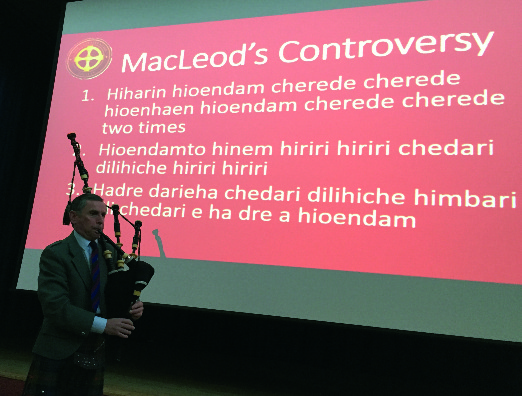The Bagpipe Society
Grace Notes

Since the last edition of Chanter, I have visited Glasgow and the National Piping Centre twice. This feels a bit like the arrival of the long awaited Number 64 bus — having not been to Scotland for over 30 years, I then have two forays north of the border within 3 months of each other. The two occasions were very different though. At the end of February I attended the bi-annual conference of the International Bagpipe Organisation (IBO) for the first time. I was so pleased to eventually make it (ironically it was cheaper for me to get to Glasgow than to London) and whilst I was there partly through duty (your editor works hard on your behalf members!) I was also relishing the opportunity to catch up with some old friends and to finally meet Cvetelin Andreev who I had been in correspondence with regarding his article for Chanter. The whole event far exceeded my expectations and, as well as thoroughly enjoying the music and the social aspects, the various papers held my attention far more than I thought they would. One of the highlights for me though, was finally — finally — understanding what piobaireachd was all about! So many thanks to Jack Taylor for a most illuminating session. (However, I have to guiltily admit to the fact that I preferred the sung version to the highland pipe one!)

Cassandre Balosso-Bardin gives a full review of the conference later in this edition. If you have dismissed the idea of attending the Conference on the basis that it will be boring and stuffy, then think again! Next time it’s in Mallorca and with the cheap flight deals available, I can get there for less than it would cost me to get to London! See you there!!
My second visit to Scotland was mainly social but, again, under the thin disguise of work. I, along with other makers, descended on Julian Goodacre’s house for the weekend with the purpose of swapping ideas, suggestions and techniques. It was a follow on from the Blowout a number of years ago, when a “collective” bagpipe was made over the course of the weekend by a number of different makers. As an observer, it struck me how it was the makers themselves who were as interested in what their peers were doing as the Blowout attendees. There was much discussion on the various processes and tools each of them used. This thought that had struck Julian as well — thus the invitation to get together to swap techniques. On the Saturday though, we all made the trip to the National Piping Centre in Glasgow to visit the Lowland and Border Pipers Society annual competition. During the afternoon, whilst I was observing the various entrants, I was struck by both the similarities and differences between the LBPS and the Bagpipe Society. Both were formed at approximately the same time, they were both started by a small, core group of enthusiasts, and both have had the very successful end result of increasing awareness and interest in the instrument.
They have also promoted the production of the instrument by increasing the number of makers. However, there are also considerable differences! Whereas the Bagpipe Society exists to promote interest, knowledge and understanding in the diversity of bagpipes played around the world from a variety of cultures, the LBPS focuses purely on border and smallpipes and predominantly on a traditional repertoire from a specific area of the country. The LBPS have chosen a very different route from our society in order to promote its aims and objectives and the annual competition is a clear example of this. I think the majority of their members would have something of a shock when confronted by the Blowout’s Friday night annual competition! Vive la difference — there’s room for us all!

This edition definitely certainly fulfils the Society’s objectives of informing people about the diversity of bagpipes played today, together with their social and cultural history as there are features on bagpipes from France, Russia and Italy. The article on the boha by Yan Crozian raises some very interesting and thought provoking issues about the development of a bagpipe outside of its home territory. I would certainly welcome your thoughts on this topic so please get in touch. Asking for a response to an article brings me neatly on to …
In the Spring 2016 edition I ran a new feature, Calls and Responses. This was due to a suggestion by more than one person that some form of Q&A section would be both useful and interesting. Being an attentive and responsive editor I did exactly that. However, having tried to start the ball rolling, I’m slightly disappointed to report that I have not received one Call or Response. I steadfastly refuse to make up responses for the sake of keeping a feature going! However, should anyone ever have a query they would like to put to the Society membership in the future, then I will be more than happy to print it in Chanter and the same equally applies to any answers I receive. In fact, I would love to be able to print more articles, letters, correspondence, debate — so please don’t hold back! If there’s anything you would like to say — then please contact me at janethepiper@gmail.com. Hint, hint!
A perfect example of how one question can encourage significant interesting discussion and debate is when, sometime ago, Ian Clabburn asked about cabrette tuning. Another (final?) response is next — more like this please!
By International Bagpipe Organisation Moulder, Jane Trad Various
From Chanter Summer 2016.
- Data Processing Notice (GDPR)
-
@BagpipeSociety on X (formally known as Twitter)
-
TheBagpipeSociety on Instagram
-
 BagpipeSociety on Facebook
BagpipeSociety on Facebook
Something wrong or missing from this page? Let us know!
